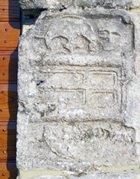

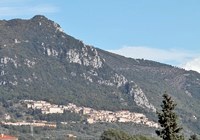
Porta Terni (13th century)
This gates, like Porta Todi (see below) stands on the site of a tower that formed part of the Rocca di Cesi, which was probably built in the 12th century. Another tower from the fortifications can be seen be seen on the side of the mountain near the isolated church of Sant’ Erasmo (see the Walk from Cesi). There were at least four other towers in the wall of the rocca of which no trace survives. From 1198, the castellan of the Rocca di Cesi was appointed by the papacy and the fortress held the key to the defense of the so-called Terre Arnolfe.
San Michele Arcangelo (11th century)
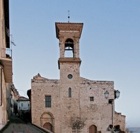
San Michele was the main church in Cesi until the middle of the 19th century, when it was deconsecrated. It is now used for exhibitions and for the annual concerts of the Settembre Musicale Cesano.
The ex-church housed an archeological collection after its deconsecration and still contains the inscribed bases of two statues from Carsulae.
[The building still contains a damaged fresco (15th century) of the Risen Christ that is sometimes attributed to Pier Matteo di Amelia.]
Two important works of art, one of which is a dossal (1308) that is the autograph work of the Maestro di Cesi, are now in the Museo Parrocchiale next to Santa Maria Assunta (see below). An altarpiece (late 16th century) of Christ with SS John the Baptist and Antony of Padua, which is signed by Bernardino Coldarchi, is now in the Pinacoteca Comunale, Terni.
Via Arnolfo into Piazza 1 Maggio
Palazzo Contelori (17th century)
Felice Contelori, the author of a history of Cesi, built this palace on the site of the old Palazzo Comunale. It is now a hotel, the Locanda di Palazzo Contelori.
Via Carlo Stocchi
Palazzo Spada-Stocchi (1637)
[Sala degli Affreschi]
The palace is now the headquarters of a local caving club (Gruppo Speleologico Terre Arnolfe) and contains the entrance to the “Grotta Eolia”. This cave system reputed to be the place in which, according to Livy, the Romans executed some 2,000 Umbrian “free-booters” in 303 BC, at the start of the Third Samnite War.
Detour which way ??
Sant’ Agnese (1611-13)
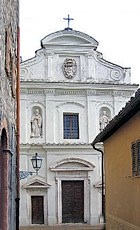
The complex now houses the Istituto Madre Francesca Peticca.
Return to Via Carlo Stocchi and continue along Via Santa Maria delle Botteghe, past the tiny Chiesa del SS Sacramento (17th century) to Piazza Umberto I. Continue along Via Angelo Cesi.
Santa Maria Assunta (1515-25)
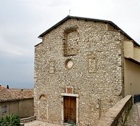
The church took on its present appearance in 1782, after it had been designated as a collegiata and therefore had to be adapted to house a small community of canons. It became the parish church of Cesi when San Michele Arcangelo (see above) was deconsecrated in the 19th century.
Part of the original church of Sant’ Antonio survives under the sacristy and is used as the office of the parish.
Crucifixion (1425)
This fresco is in the surviving part of Sant’ Antonio that survives under the sacristy. Its inscription is no longer legible, but a transcription of it survives in a guide of 1675 (“Memorie Historiche della Terra di Cesi” by Nicolò Angelo Tinassi). I am grateful to Dottore Giuseppe Fortunati for drawing it to my attention. The document records:
“Shortly after [the church was built], the history of the Crucifixion of Our Lord Jesus on Mount Calvary was painted in the tribune, under which we read the following words:
-
‘Hoc opus fecit fieri Ursella pro anima Agnesella Coluccia e Suorum defunctorum sub anno Domini 1425 tempore D. Martini Papa Quinti, indictione quinta, mense Madii die XXVI. Ioannes Iueenelli de Narnia pinxit hoc opus anno 1425’”.
My translation of the inscription is:
-
“This work was made by Ursella for the soul of Agnesella Coluccio, who died on 26th May 1425 in the reign of Pope Martin V.
-
Giovanni di Giovanello di Paolello of Narnia painted this work in 1425”
Madonna and Child (ca. 1538)
This fresco, which was originally part of a larger composition, was detached from the left wall in 1922 and moved to its current location, in a room off the sacristy. It is probably the fresco by Tommaso Bernabei, il Papacello that was documented in 1540, when Giovanni Battista Caporali and il Papacello were contracted to “correct” such a work, for which payment was still outstanding.
Madonna and Child (17th century)
This altarpiece on the high altar, which depicts the Assumption of the Virgin, is attributed to Girolamo Troppa.
Crucifixion with saints (17th century)
This altarpiece, which depicts the Crucifixion with SS John the Evangelist and Charles Borromeo, is by Bartolomeo Barbiani.
Works in the Museo Parrocchiale
The adjacent museum contains two works from San Michele Arcangelo (see above):
-
✴a wooden statue (12th century) of the Madonna and Child; and
-
✴the important dossal (1308) that is the autograph work of the so-called Maestro di Cesi.
Palazzo Cesi (16th century)
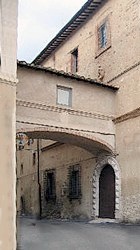
Santa Caterina (1652)
This church was built as a private chapel for the adjacent Palazzo Eustachi (previously Palazzo Pressio Colonnese).
Sant' Andrea (1160)
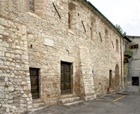
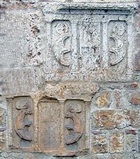
The church contains a fresco (1520) of St Lucy with SS Sebastian and Roch that is the autograph work of the so-called Maestro della S. Lucia di Cesi.
Porta Todi (13th century)
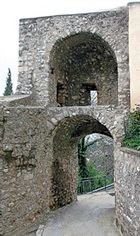
Outside the Town
Two interesting churches can be seen by taking a short detour through Porta Terni and continuing along Via Regina Elena towards Carsulae.
Santa Maria della Pittura (17th century)
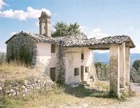
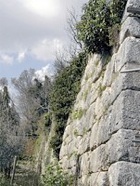
Santa Maria di Fuori (11th century)
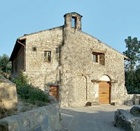
Return to the page on Walks in Cesi.
